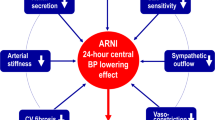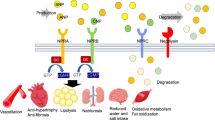Abstract
Plasma renin activity and cardiovascular disease (CVD) incidence correlate closely in people with hypertension. The effects of angiotensin II (Ang II) on blood pressure (BP) are important in hypertensive patients; accumulating data suggest that the growth effects of Ang II in the cardiovascular system play a critical role in the development of atherosclerosis. Atherosclerosis development in hypertensive patients requires fundamental changes in endothelial structure and function. Key among the factors that may affect the endothelium is the renin–angiotensin–bradykinin system. Ang II, independent of other environmental and neurohormonal factors, mediates the vessel wall changes critical for the development of atherosclerotic disease. A strong correlation appears to exist between Ang II and CVD. Blockade of the renin–angiotensin system has a major impact on arterial structure and function independent of BP. Certain angiotensin-converting enzyme (ACE) inhibitors produce significant improvements in arterial compliance, which may yield a reduction in cardiovascular events. Blockade of the neurohormonal system may be a critical first-line approach to management of hypertension in an effort to prevent or reverse endothelial dysfunction. Moreover, the effects of ACE inhibition, in addition to its effect on BP, suggest that this therapeutic approach may be appropriate for managing patients at risk of CVD who do not yet have hypertension. The ideal antihypertensive agent should yield smooth, consistent BP control over the entire 24-hour period, both to avoid BP variability that places patients at increased risk of cardiovascular events and to offer protection during the vulnerable early morning hours when patients are well known to be at high risk.
This is a preview of subscription content, access via your institution
Access options
Subscribe to this journal
Receive 12 digital issues and online access to articles
$119.00 per year
only $9.92 per issue
Buy this article
- Purchase on Springer Link
- Instant access to full article PDF
Prices may be subject to local taxes which are calculated during checkout








Similar content being viewed by others
References
American Heart Association. Heart and Stroke Facts Statistical Update. American Heart Association: Dallas, TX, 2002.
McMahon S et al. Blood pressure, stroke and coronary heart disease. Part 1, prolonged differences in blood pressure: prospective observational studies corrected for the regression dilution. Lancet 1990; 335: 765–774.
Grimm RH, et al, for the MIDAS Research Group. A comparison of antihypertensive drug effects on the progression of extracranial carotid atherosclerosis: the multicenter isradipine diuretic atherosclerosis study (MIDAS). Drugs 1990; 4 (Suppl 2): 38–43.
Havlik RJ et al. Antihypertensive drug therapy and survival by treatment status in a national survey. Hypertension 1989; 1 (Suppl I): I-28–I-32.
Kannel WB . Blood pressure as a cardiovascular risk factor. Prevention and treatment. JAMA 1996; 275: 1571–1576.
Celentano A et al. Blood pressure and cardiac morphology in young children of hypertensive subjects. J Hypertens 1988; 6 (Suppl 4): S107–S109.
Dzau VJ . Atherosclerosis and hypertension: mechanisms and interrelationships. J Cardiovasc Pharmacol 1990; 15 (Suppl 5): S59–S64.
Dzau VJ . Tissue renin–angiotensin system: physiologic and pharmacologic implications. Circulation 1988; 77: I1–I3.
Glasser SP, Selwyn AP, Ganz P . Atherosclerosis: risk factors and the vascular endothelium. Am Heart J 1996; 131: 379–384.
Neutel JM et al. Heredity and hypertension: impact on metabolic characteristics. Am Heart J 1992; 124: 435–440.
Gibbons GH . Endothelial function as a determinant of vascular function and structure: a new therapeutic target. Am J Cardiol 1997; 79 (Suppl 5A): 3–8.
Neutel JM, Smith DHG, Graettinger WF, Weber MA . Dependency of arterial compliance on circulating neuroendocrine and metabolic factors in normal subjects. Am J Cardiol 1992; 69: 1340–1344.
Neutel JM . Why lowering blood pressure is not enough. The hypertension syndrome and the clinical context of cardiovascular risk reduction. Heart Dis 2000; 2: 370–374.
Lonn EM et al. Emerging role of angiotensin-converting enzyme inhibitors in cardiac and vascular protection. Circulation 1994; 90: 2056–2069.
Brunner HR et al. Essential hypertension: renin and aldosterone, heart attack and stroke. N Engl J Med 1972; 286: 441–449.
Alderman MH et al. Association of the renin–sodium profile with the risk of myocardial infarction in patients with hypertension. N Engl J Med 1991; 324: 1098–1104.
Laragh J . Review course. Laragh's lessons in pathophysiology and clinical pearls for treating hypertension. Am J Hypertens 2001; 41: 84–89.
Dzau VJ . Tissue angiotensin and pathobiology of vascular disease: a unifying hypothesis. Hypertension 2001; 37: 1047–1052.
Gibbons GH . Endothelial function as a determinant of vascular function and structure: a new therapeutic target. Am J Cardiol 1997; 79: 3–8.
Dzau VJ . Tissue renin–angiotensin system in myocardial hypertrophy and failure. Arch Intern Med 1993; 153: 937–942.
Ross R . Atherosclerosis—an inflammatory disease. N Engl J Med 1999; 340: 115–126.
Nickenig G et al. Upregulation of vascular angiotensin II receptor gene expression by low-density lipoprotein in vascular smooth muscle cells. Circulation 1997; 95: 473–478.
de las Heras N et al. AT1 receptor antagonism reduces endothelial dysfunction and intimal thickening in atherosclerotic rabbits. Hypertension 1999; 34 (Part 2): 969–997.
Gibbons GH, Dzau VJ . The emerging concept of vascular remodeling. N Engl J Med 1994; 330: 1431–1438.
Cohn JN et al. Noninvasive pulse wave analysis for the early detection of vascular disease. Hypertension 1995; 26: 503–508.
Daugherty A, Manning MW, Cassis LA . Angiotensin II promotes atherosclerotic lesions and aneurysms in apolipoprotein E-deficient mice. J Clin Invest 2000; 105: 1605–1612.
Baron AD . The coupling of glucose metabolism and perfusion in human skeletal muscle. The potential role of endothelium-derived nitric oxide. Diabetes 1996; 45 (Suppl 1): S105–S109.
Baron AD . Vascular reactivity. Am J Cardiol 1999; 84: 25J–27J.
Baron AD . Insulin and the vasculature—old actors, new roles. J Invest Med 1996; 44: 406–412.
Weber MA, Smith DHG, Neutel JM, Graettinger WF . Arterial properties of early hypertension. J Hum Hyper tens 1991; 5: 417–423.
Clozel J-P, Kuhn H, Hefti F . Decreases of vascular hypertrophy in four different types of arteries in spontaneously hypertensive rats. Am J Med 1989; 87 (Suppl 6B): 92S–95S.
Asmar RG et al. Reversion of cardiac hypertrophy and reduced arterial compliance after converting enzyme inhibition in essential hypertension. Circulation 1988; 78: 941–950.
Sihm I et al. Normalization of structural cardiovascular changes during antihypertensive treatment with a regimen based on the ACE-inhibitor perindopril. Blood Press 1995; 4: 241–248.
Thybo NK et al. Effect of antihypertensive treatment on small arteries of patients with previously untreated essential hypertension. Hypertension 1995; 25 (Part I): 474–481.
Weber MA . The angiotensin II receptor blockers: opportunities across the spectrum of cardiovascular disease. Rev Cardiovasc Med 2002; 3: 183–191.
White WB, Dey HM, Schulman P . Assessment of the daily blood pressure load as a determinant of cardiac function in patients with mild-to-moderate hypertension. Am Heart J 1989; 118: 782–795.
Frattola A et al. Prognostic value of 24-hour blood pressure variability. J Hypertens 1993; 11: 1133–1137.
Deedwania PC, Nelson JR . Pathophysiology of silent myocardial ischemia during daily life. Hemodynamic evaluation by simultaneous electrocardiographic and blood pressure monitoring. Circulation 1990; 82: 1296–1304.
Muller JE et al. Circadian variation in the frequency of onset of acute myocardial infarction. N Engl J Med 1985; 313: 1315–1322.
White CM . Pharmacologic, pharmacokinetic, and therapeutic differences among ACE inhibitors. Pharmacotherapy 1998; 18: 588–599.
Monopril® (product information). Bristol-Myers Squibb. Physician's Desk Reference®, Available at: www.pdrel.com/pdr/static.htm?path=pdrel/pdr/10451000.htm. Accessed on 29 August 2002.
Lotensin® (product information). Novartis Pharmaceuticals Corporation. Physician's Desk Reference®, 58th edn. Thomson PDR: Montvale,NJ, 2004, pp. 2279–2284.
Aceon® (product information). Solvay Pharmaceuticals, Inc. Physician's Desk Reference®, 58th edn. Thomson PDR: Montvale, NJ. 2004, pp. 3163–3165.
Accupril® (product information). Parke-Davis, A Division of Warner-Lambert Company LLC, A Pfizer Company. Physician's Desk Reference, 58th edn. Thomson PDR: Montvale, NJ, 2004, pp. 2516–2519.
Altace® (product information). Monarch Pharmaceuticals a wholly owned subsidiary of King Pharmaceuticals, Inc. Physician's Desk Reference®, 58th edn. Thomson PDR: Montvale, NJ, 2004, pp. 2142–2145.
Mavik® (product information). Abbott Laboratories. Physician's Desk Reference®, 58th edn. Thomson PDR: Montvale, NJ, 2004, pp. 489–491.
Meredith PA, Elliott HL . Concentration–effect relationships and implications for trough-to-peak ratio. Am J Hypertens 1996; 9: 66S–70S.
Acknowledgements
I thank Solvay Pharmaceuticals for its support for this work.
Author information
Authors and Affiliations
Corresponding author
Rights and permissions
About this article
Cite this article
Neutel, J. Effect of the renin–angiotensin system on the vessel wall: using ACE inhibition to improve endothelial function. J Hum Hypertens 18, 599–606 (2004). https://doi.org/10.1038/sj.jhh.1001714
Received:
Revised:
Accepted:
Published:
Issue Date:
DOI: https://doi.org/10.1038/sj.jhh.1001714



